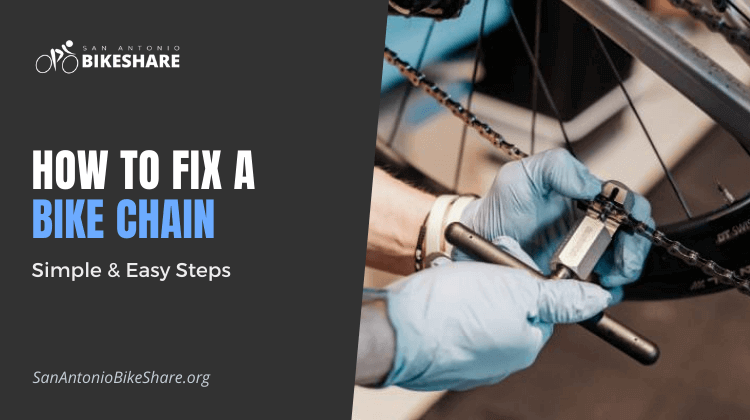How to Fix a Bike Chain: Simple & Easy Steps
This article will explain how to fix a bike chain in a few simple steps. Let’s start!
Being trapped on the path is never a good thing. It’s one of the key reasons we always advise our readers to cycle in pairs or groups.
Learning basic bike repair abilities, on the other hand, can boost your confidence while solo riding and make you the hero of the day if your partner’s bike goes down.
A broken chain is a common occurrence, particularly among mountain bikers, and understanding how to remove and fix a bike chain is an essential skill for any rider.
The good news is that, with appropriate preparation, fixing a broken chain is no more difficult than fixing a flat tire on the road.
In the section below, we’ll go over everything you need to know about how to fix a bike chain, but first, let’s become acquainted with the tools you’ll need to get the job done well.
Tools Required for Fixing a Bike Chain
The chain tool is the only thing you’ll need. If you’re not familiar with a chain tool, it’s a little tool that’s usually included in many common multi-tools, and you may already have one in your toolkit without realizing it.
While a hammer and pliers can be used to fix your broken chain, it’s a more difficult operation, and the chain tool is the only practical and convenient option on the street.
How to Fix a Bike Chain
Let’s look at what you should do if your bike chain breaks and has to be repaired.
However, you should be aware that you will need to get your hands dirty, and it is generally advisable to change into your old soiled jeans first if you are wearing nice clothes. Fixing a bike chain is the dirtiest job on a bike. Here’s how you do it:
- To make it easier to get the chain and keep your bike from sliding over while you’re working, turn it over. When the bike is turned upside down, let it rest on the seat and handlebars. You may also use a bike stand, but you’re unlikely to have one as the majority of the chain breaks along the journey. Place the front wheel over a wide horizontal rod instead, and keep the bike at least four feet above the ground.
- Examine the two broken ends of the chain. We strongly urge that you remove both segments of your bike chain because they normally alternate, and removing simply one will hinder you from reattaching it effectively.
- After you’ve removed the two segments, place the chain in the chain tool at the spot where you want to disconnect it. Follow the steps above if you wish to replace a worn but not broken chain.
- To help drive the pinout of the chain, start spinning the screws with your chain tool. When twisting the screw, keep the pin on the chain tool in proper alignment with the pin on the chain to avoid slippage.
- Again, don’t extend the pin so far that it separates from the chain. Instead, only proceed as far as is necessary to separate the chain. You should leave a part of the pin in the chain to make pushing easier.
- Now that the pin has been removed from the chain, it’s time to reattach the chain to its sprockets. It’s easier to combine two ends if you have someone to hold them together.
- When you’ve completed feeding the chain to the sprockets, use your chain tool to press the pin back in place. Keeping the chain tool in line with the pin while pushing the chain back is a tremendous difficulty. If you’re installing a new chain, though, you’re in luck because many of them feature a special link that allows you to install it without using pins for the first time.
- Once you’ve attached the broken link, you’ll undoubtedly find that it’s stiff. Working the chain back and forth until it is slack enough to bend can prevent stiffness.
You should be able to fix your broken bike chain if you follow the steps outlined above.
How to Prevent Bike Chain from Breaking
While a broken bike chain cannot be avoided, you can reduce the chances of difficulties by following the procedures below:
Learn to Shift the Gears Properly
A broken chain is frequently caused by improper moving. If you don’t shift properly, your drivetrain will be overworked, and your chain will only stretch so far before breaking or slipping.
Shifting gears move the chain and doing so while mounting a slope may cause the chain to miss the teeth of the next gear.
When shifting gears, keep the following points in mind:
- Shift the gears before reaching a hill. Don’t wait until you can hardly pedal, to put it another way. In any case, your feet should always go at the same speed.
- Use “soft pressure” when shifting, or ease up on the pedals as if you were letting go of the throttle.
Adjust Your Limit Screws
If your chain has constantly fallen out in the same direction, especially while shifting to one of your extreme gears, you can limit the screws to signal the derailleur to cease moving in one direction.
Replace Worn-Out Chains
The gear teeth are unable to lock firmly in place in the chain when chains and cassettes wear out over time due to friction.
As a result, replacing worn chains is essential for lowering the danger of chain failure.
Conclusion
Chains connect the drivetrain to the pedals; thus, they’re a vital part of your bike. Because an issue with your chain will ruin all of your efforts, knowing how to fix a bike chain and lessen the risk of breaking it, is vital.
Recommended Posts:







